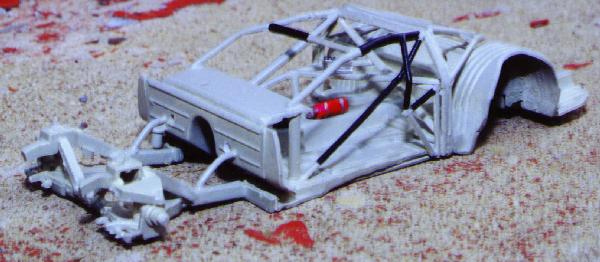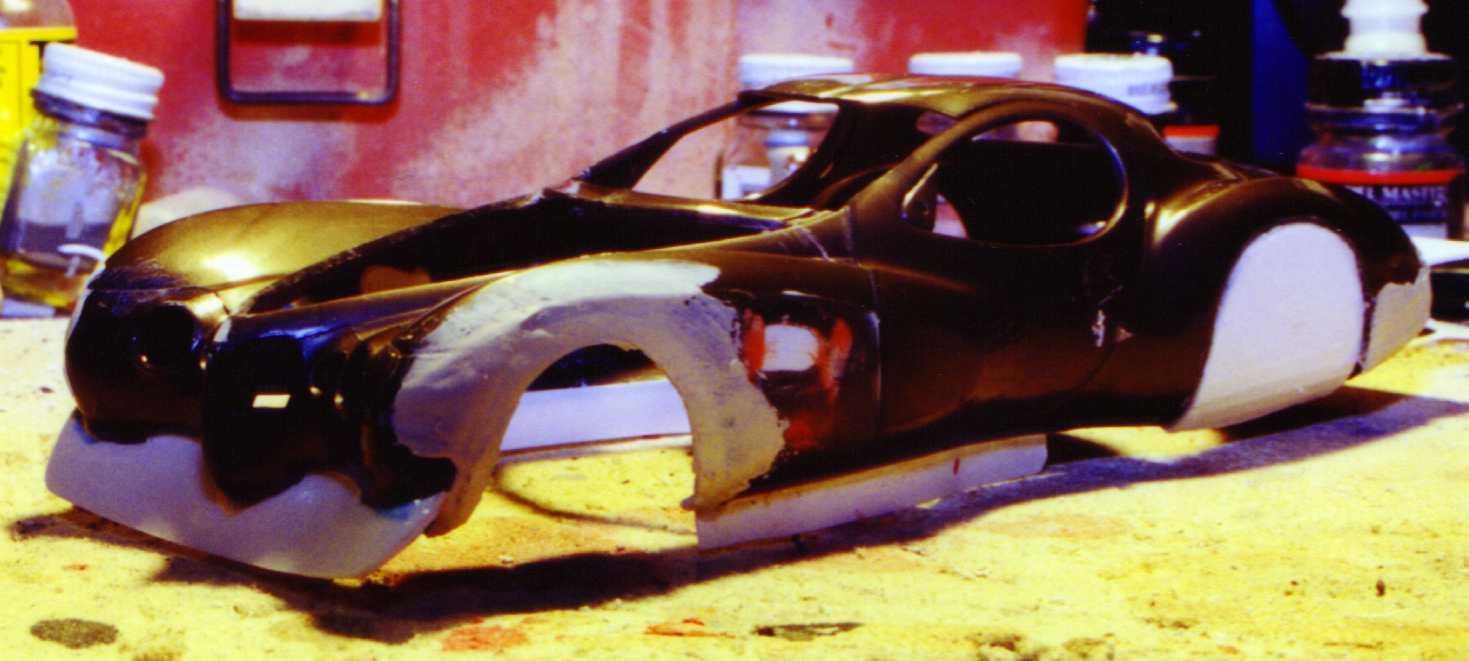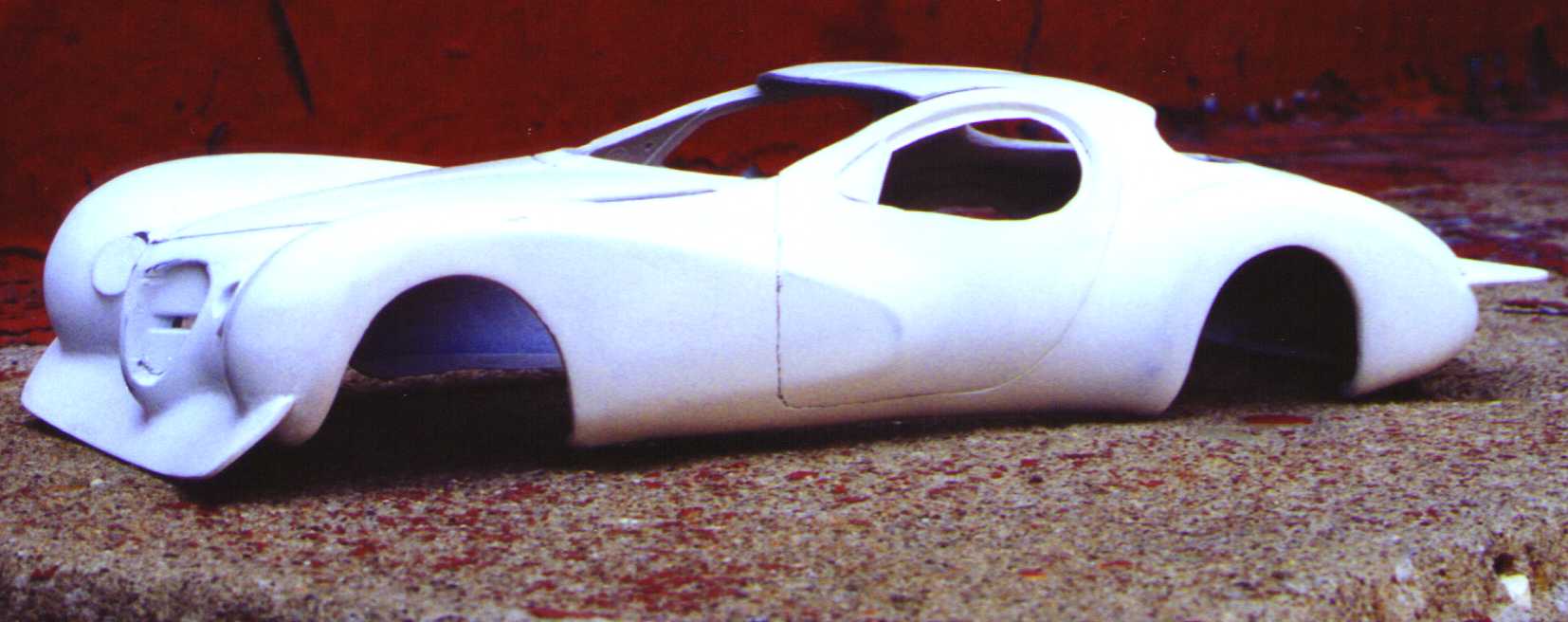Truth or Fantasy?
You decide.
Robb's Scale Auto Modeling Page presents the story of the
Atlantic Hurricane
A tale of mystery, Friendship,
and a passion for salt and speed.
(Key word here is TALE!)
Prelude
Almost 40 years ago, the engineers at Chrysler
Corporation, (now Daimler Chrysler) were hard at work putting the finishing
touches on their new engineering test, the Chysler/Ghia Turbine car. It had a
(for the time) Space-Age design, and a 21st century powerplant, the A83-1 gas
turbine engine. Approximately 55 were built, and loaned out to 203
people for 3 months at a time. The people were asked what they thought of them.
They were returned to ChryCo afterward, and except for 9 of them, were destroyed
between 1967 and 1969 at the behest of the Federal government, due to beleive it
or not expired visas! Makes you wonder about the terrorists of 9/11, doesn't it?
Then, in 1995,
Chrysler brought to the show car circuit the Chrysler Atlantic. To quote the
ChryCo folks, "The Chrysler Atlantic was
designed in the spirit of luxury French custom coach builders of the late '30s,
who created distinctive, highly-stylistic design statements that were purebred
luxury coupes. Under the long, graceful hood lies a 4.0-liter "straight eight"
engine with dual overhead cams and 32 valves. Front and rear tires are huge --
21- and 22-inches, respectively. Atlantic was designed to be what a two-door
luxury performance car was meant to be bold, beautiful, sophisticated
and bigger than life."
One
Here's where the line between reality and
fantasy becomes blurred. In 2001, in the Engineering section of Daimler
Chrysler, an unnamed schlep, tasked with cleaning out a storage area came across
a strange object. It was roughly 20 inches around, not quite spherical,
and coated with what appeared to be 40 years of crud. When schlep asked the
engineer in charge, a brash kid just hired out of Michigan
State 4 months earlier, what he should do with it, he was told, "Throw the
damn thing out! I thought I told you to get this area clean!" Now, our
Schlep wasn't the most educated guy in the department, but a voice in his
head told him this was something special. So, instead of throwing the
strange object away, he spirited it out of the Highland Park
complex hidden in the trunk of his 1980 Aspen, determined to find out
what this strange but wonderful thing was. It had sat in Schlep's
ratty garage in the suburbs of Detroit for some three months when an unfortunate
turn of events befell him. Schlep, while on his way to a KISS concert
at Cobo Hall, was killed when he was catapulted through the windshield of
his Aspen after crossing over into the opposing lane of traffic and hitting
a delivery truck head-on. With no family to speak of, Schlep's worldly
possessions were put up for sale.
Two
Retired engineer Rob Clifford was perusing the
Detroit Free Press when he saw the
legal notice regarding Schlep's belongings. Rob knew Schlep from the department
but never said more than a hello when they met coming into work in the
mornings. But something told Rob to go over and have a look, just in
case. When Rob arrived at Schlep's home, he was not really surprised to
find no-one there besides, of course, the requisite lawyer type. It seems that
Schlep was a bit of a pack rat. There was a little of everything in his garage.
Old F-body parts, a few odds and ends, and piles of assorted junk. But
there in the corner, sat something that Rob had not seen the likes of in 35
years, and was not real sure he was seeing now. Rob asked the lawyer what the
estate was hoping to get for it. The response was, "Looks like junk to me, I
figure maybe a hundred and fifty bucks would work." Rob gave the leech, I mean,
lawyer the one-fifty, and started to leave. The lawyer asked, " What is that
thing anyway?" Rob said that it was a planter that used to be in his old office
at Chrysler Engineering. To which the lawyer said, "that's a funny looking
planter." Rob mumbled something about one man's junk being another man's
treasure, and beat a path to his Ram R/T, prize in
hand.
Three
Now, Rob still had a few contacts at
Daimler-Chrysler. And, he had a plan for his accquisition. After calling in a
few favors, Rob was able to purchase an engineering mule from Mopar
Perfomance. It was a front-steer NASCAR chassis that was used for
development work on the Winston Cup program. There was a lot missing from it,
but It would make a good starting point. Some old freinds from the local
Street Rod club pointed him to a Halibrand quick-change rear axle that
was kind of beat up, but could be rebuilt. Another former employee at
the department provided a Torque-Flite automatic trans, and although it was
missing the converter, this would not be a problem. Some off the shelf parts
from a Ram pickup, and most of the pieces were in place to start Rob's dream
project.
Four
At this point Rob had to do some
reasearch. Having been a Chrysler engineer, he had worked on some interesting
stuff. Concept cars, test mules, trucks, he had an opportunity to work on
most of them. But one thing he never got to do, basically because there wasn't
much interest for it at Highland Park, was an Land Speed Record attempt. For
some reason upper management, particularly Iaccoca, had no use for racing. He
just didn't beleive that it would help sell cars. "How short sighted can one man
be?" asked Rob on many occasions. Mostly, the answer was a
shrug of the shoulders. Well, now the idea that had been brewing in the back
of Rob's mind for 30 years would come to life. An email to some
friends in Southern California led to finding out that the SCTA
had a class for what he had in mind. The 'planter' he had procured from Schlep's
estate sale was the key. The A83-1 gas turbine engine had spent it's former life
in a 1963 Chrysler/Ghia Turbine car. When the Feds in their typical ham-handed
way demanded either a large sum of money from ChryCo or to have the beautiful
Bronze cars destroyed for what amounted to an expired visa, Ma
Mopar decided to destroy the cars. Some enlightened engineer had decided to
save at least one of the A83's from being recycled and stashed it away in
the storage area of the engineering department. How Schlep accquired it,
Rob didn't know. But now it would live again. The chassis parts and the
engine were here, but what to cloak it in? Here, luck was to play a
role again. Rob's old buddy at Styling, Dave V, came to the rescue. Dave
had somehow salvaged the original body bucks for the Chrysler Atlantic
concept car. The swoopy, somewhat retro body could be reincarnated in carbon
fiber, and another compatriot at Lockeed could get hime some CF
at what he called a "reduced price". When Larry also promised to help
lay out the bodywork, Rob was ready to start building what promised to be one of
the wildest cars to ever turn a tire on salt.
Five
Rob decided to get a "roller" going first. The
NASCAR chassis was a 'drop snout" chassis, but was missing the snout. Knowing
that the Atlantic was a long wheelbase car, this would not be a problem.
Extending the chassis to approximately the Atlantic's dimensions with
some recantgular chrome moly tube, he mounted a basically stock
Ram R/T a-arm front suspension (minus the braking system which would only
add unsprung weight, and besides, a 'chute would cover that). Using the body
buck to get the shape and dimensions correct, Rob laid out and assembled a light
but strong rollcage. The Halibrand was next, and it was mounted on NASCAR
type "truck arms". Then a set of Goodyer slicks and Front Runners mounted
on alloy wheels capped with spun discs finished the basic chassis.
Six
The bodywork would prove to be tougher that Rob thought it
would. When Larry, Rob's bud at Lockheed had the CF delivered, Rob realized
he didn't know squat about carbon fiber. A quick call to Larry provided
(after Rob promised pizza and beer) enough help to get the body laid out.
There were some minor changes made to the design of the body to keep it
from lifting at the hoped for terminal speed of 280 MPH. A huge aim dam was
added to the front of the Atlantic, and a horizontal rear spoiler were
installed to better manage the air molecules sliding over and around the car.
Basic cleanup of the geegaws and closing off most of the openings on the front
valence would finish the job. Dave did whine a bit about the air dam, which he
dubbed "The Cowcatcher" since he thought it made the car look like a steam
engine. But since he had a few too many beers at that point anyway, Rob just
laughed it off. Besides, at the speed this piece would be going through the
traps at, it needed all the downforce it could
get!
Seven
Well, after what Rob beleived to be a record,
(10 large Pizza Hut pizzas, 6 cases of Stroh's and 2 weeks of work) the CF body
was done. Dave actually started to like the way it turned out, and didn't whine
so much about "The Cowcatcher" anymore, either. The Body was mounted to the
chassis, and "The Crew" finished up the assembly work. But it was
still in white primer, and it didn't even have a name yet. As far as Rob
was concerned, the choice of color was a no-brainer. Pearl Orange, a color
smilar to what Rob had seen on the Sidewinder Dakota concept would give the
Atlantic a touch of flash. The name was suggested by Dave.
"Since we know it will blow everything else on the salt
away, and it IS an Atlantic, how about Atlantic Hurricane?" A moment
of uncomfortable silence followed by hoots and hollers
loud enough to rival a Gibson Les Paul blowing through a Marshall stack
gave Dave his answer. Thus was born one of the most unusual cars ever to
see Bonneville.
Reality
OK, for those of you who stuck
around while I tried my hand at fiction, A BIG Thanks! here's the real
story. A couple of months ago, I saw a article in Scale
Auto by Drew Hierwater. It was about LSR cars, more specifically the kind of
stuff you see at SCTA meets. In Drew's piece, he used a NASCAR '98 Taurus for
the subject, and it WAS pretty cool. Cool enough for me to give it a shot. But I
felt more could be done. I felt that since one tends to see lots of rather
strange rides at the salt flats, (How about a 200 MPH International diesel
tractor, for instance?) why not go WAY out there? After about 10 minutes
of digging through my spare parts pile, I uncovered a Lindberg Chrysler
Atlantic. Well, the gears in my head started to turn, (slowly, of course) and I
remembered the JoHan Chrysler Turbine Cars I had purchased on ebay. The second
one, was an already built kit, (poorly built I might add) and
suddenly the idea of a Turbine powered LSR was starting to sound REAL good.
So, at this point some reasearch was in order. After checking on a few sites on
the Internet, I found that the SCTA not only had a class for turbines, but some
rather notable individuals had run them. Donald Campbell of England ran a
Turbine powered car at Bonneville. (see pic below)
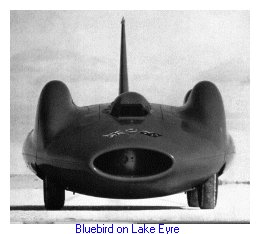
Also, just recently Team Vesco
set a new wheel driven LSR with the Turbinator.

So, I learned that the concept had already been
proven. So with the idea in my head, and the parts on the workbench, I started
off. Drew's car was basically a slightly modified NASCAR Taurus on a regular
stock car chassis. The stock car chassis was do-able since I had a AMT generic
Monte Carlo partial kit on the shelf. It would require some modifications,
however. Since the Atlantic's wheelbase was about 5/8" longer that the
Monte's, I had to stretch it out. I used the chassis pretty much box stock
after that, except for a few considerations. First, the front a-arms were
missing. These were replaced by some pieces from a Dodge Ram VTS. And, since
many Bonneville racers use a Halibrand quick-change rear axle, I used one from
the '50 Austin gasser.Rear suspension was NASCAR truck arms with hand wound coil
springs. The roll cage was constructed from a stock car piece I retreived from
an AMT '75 Matador kit with some mods to make it fit the Atlantic's roofline.
The seat was from the Matador kit, and so was the steering wheel.
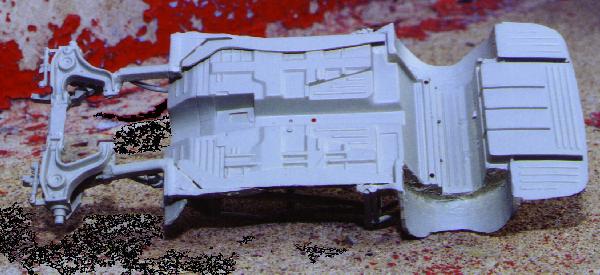
Here's a shot of the salty side of the chassis.
It's basically a NASCAR chassis that has been lenthened about 5/8" due to the
length of the Atlantic's wheelbase. The lower a-arms are from a Ram VTS truck.
They may be a bit big, but they solved a lot of problems.
OK, here's the top side. The roll cage was
modified from a NASCAR '75 Matador's piece with what I felt was enough
extra bracing to get the look right. The firewall was extended out to meet the
bodywork. The upper a-ars are also from the VTS Ram.
The finished chassis. The seat is from the
Matador kit, wheels and tires are parts box items. The belts are Detail Master
stuff.
The body in progress. The technique I used to
re-radius the wheelwells is shown here. I bent and glued sheet styrene, then
used the Dremel to clear out the openings to a more usable size and shape. A
little putty, and..........................
Presto!
Body-in-white! Or at least, that's what it used to be called. Like Drew's
example in SA, I
used a horizontal spoiler, since the it would need to smooth out the
airfow, not necessarily force the tail down. Also, I added some .020 styrene
around the window openings for a place to mount the side
glass.
Here's the finished car! The spun wheel discs
are from Parts by Parks.
Rear 3/4 view. I am very pleased with
the way this one turned out.
For those of you who might ask, I
figured any car with "hurricane" in it's name would naturally be sponsored by
The Weather Channel! The decals are a combination of old NASCAR contingency, and
some things i printed on my PC.
 Back to The Paddock
Back to The Paddock




